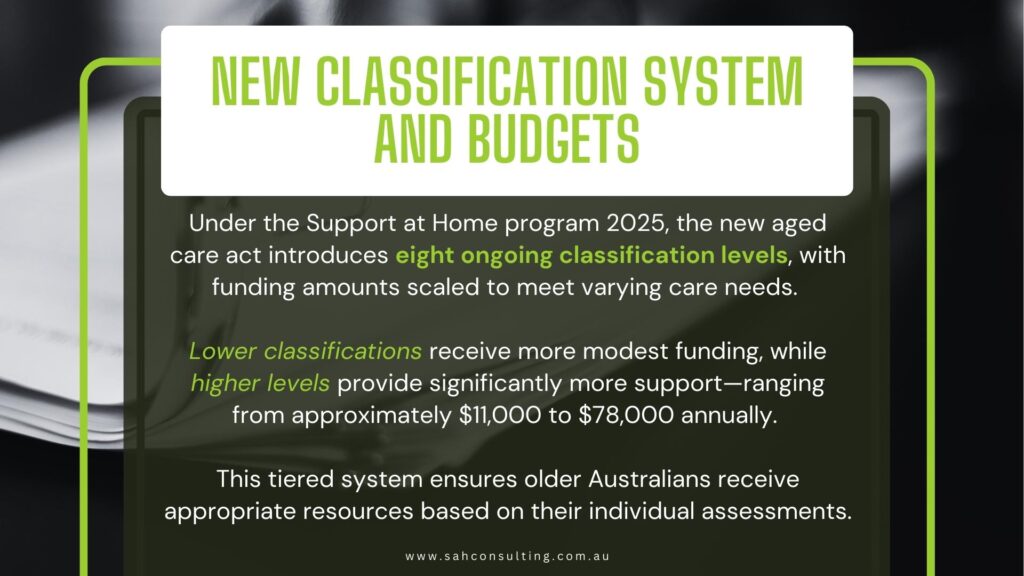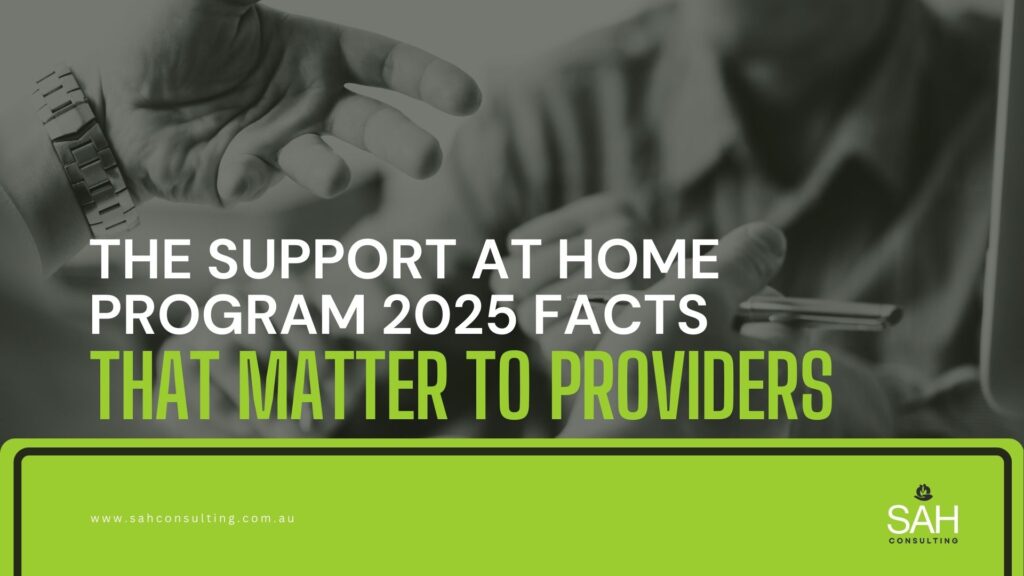Big changes are on the horizon for aged care providers. From 1 July 2025, the new Support at Home program 2025 will officially replace the Home Care Packages (HCP) and Short-Term Restorative Care (STRC) programmes. This marks a major shift in how home care is delivered, funded, and managed across Australia.
While the Commonwealth Home Support Programme (CHSP) will remain separate for now, it’s set to transition no earlier than July 2027. That gives providers time—but not forever—to prepare.
Staying informed isn’t just helpful—it’s essential. Providers need to understand how these changes impact funding, service delivery, reassessments, and their role in supporting clients. Getting ahead of the transition will mean smoother operations, better client outcomes, and fewer surprises.
Now’s the time to get across the key updates, plan your internal changes, and ensure your team is ready for what’s next.
What’s Changing in 2025?
Automatic Transition: What Happens to Existing Clients?
From 1 July 2025, the new Support at Home program will officially replace the Home Care Packages (HCP) and Short-Term Restorative Care (STRC) programs. If you’re already receiving services under HCP or are on the National Priority System, there’s no need to worry about reassessments—your transition will be automatic.
Your funding level will reflect your current Home Care Package or approved level if you’re still waiting. Any unspent funds will carry over and remain available for use, including for additional services if your quarterly budget runs out, or for assistive technology and home modifications (if approved).
Key Program Changes That Affect Providers
The 2025 rollout brings several updates that aged care providers need to understand:
Quarterly Budgeting System
Annual package funds will now be distributed quarterly. That means each recipient gets four budgets per year, each covering three months. If part of the quarterly amount goes unused, up to $1,000 or 10% of the budget (whichever is higher) can be rolled over into the next quarter.
Service List Clarity
Support at Home will introduce a clearly defined list of services. Inclusions and exclusions will be standardised, removing ambiguity. For example, pet-related services will be excluded, but funding will remain for assistive dogs under separate arrangements.
Pricing and Administration
The old model of separate admin fees is being phased out. Instead, all pricing will be bundled into the cost of services. Also, 10% of each recipient’s quarterly budget will be allocated for care management support.
These changes aim to streamline processes, improve transparency, and reduce hidden costs—benefiting both providers and recipients.
New Classification System and Budgets
Under the Support at Home program 2025, funding will be aligned to eight new ongoing classification levels, each reflecting a person’s assessed care needs. These classifications help determine the amount of funding older Australians receive to access the services they need to live independently at home.
The new aged care act introduces eight ongoing classification levels, with funding amounts scaled to meet varying care needs. Lower classifications receive more modest funding, while higher levels provide significantly more support—ranging from approximately $11,000 to $78,000 annually. This tiered system ensures older Australians receive appropriate resources based on their individual assessments.

Special Pathways
Restorative Care Pathway
- Funding: ~$6,000 over 12 weeks (may increase to ~$12,000 when eligible)
- Can be accessed in addition to an ongoing classification
- Designed for people who may benefit from short-term reablement and therapy
- After completion, a reassessment will determine the need for ongoing services
End-of-Life Pathway
- Funding: Up to ~$25,000 over a 12-week period (can extend to 16 weeks)
- For people with a prognosis of less than three months to live
- Provides support for people wishing to die with dignity at home
- Replaces the participant’s ongoing budget during this period
- Only accessible once in a participant’s lifetime
- If the participant’s health improves, they may transition to a suitable ongoing classification
Both pathways include access to assistive technology under the AT-HM Scheme. Importantly, services delivered under the Restorative Care Pathway must not duplicate those already accessed under an ongoing budget.
Assistive Technology and Home Modifications (AT-HM) Scheme
Under the Support at Home program 2025, funding for assistive technology and home modifications is provided separately from a person’s quarterly care budget. This funding is approved during the assessment process and tailored to the individual’s specific needs.
Importantly, any unspent Home Care Package (HCP) funds must be used first before participants can access the new AT-HM scheme funds. While most AT-HM funding is not eligible for rollover between years, an exception is made for assistive dog allocations, which are reviewed and renewed annually.
Income-Related Contributions and “No Worse Off” Guarantees
The transition to the new aged care act includes strong protections to ensure no one is financially disadvantaged. Existing income-tested care fee arrangements will remain in place for current HCP recipients.
Additionally, “no worse off” principles and grandfathering policies ensure that those moving into the new system retain the same financial contribution structure they had under their previous package. Even if a participant is reassessed under the new program, they will not pay more due to a change in classification.
Reassessments: When and How They Work
As outlined in the Support at Home transition Guide, clients will not need a reassessment when the program rolls out on 1 July 2025. Home Care Package (HCP) recipients and those approved under the National Priority System will be automatically transitioned to a Support at Home classification that reflects their current or approved package level.
However, reassessments can be requested if a participant’s needs change. Clients may initiate this process, or providers can assist by arranging a Support Plan Review through My Aged Care. Importantly, any unspent HCP funds will remain available after the transition and can continue to be used for approved services—they are not time-limited and will not be forfeited during reassessment.
Communication and Provider Roles During the Transition
To support a smooth transition, the government is rolling out education campaigns for older Australians, their carers, and families. This includes newsletters—like the Department of Health and Aged Care’s EngAged newsletter—and updated resources that will explain what to expect under the new program.
Providers will play a central role during the transition. As trusted sources of support and guidance, they are expected to help clients understand the changes and answer any questions about their services or funding. In parallel, Services Australia will continue to handle financial assessments, ensuring participants are informed about their income-based contributions and obligations under the new system.
What’s Next? Manuals, CHSP Integration, and Provider Preparation
As we approach the rollout of the Support at Home program, providers can expect the official program manual to be released in early 2025. This will offer detailed operational guidance to support implementation. Meanwhile, the Commonwealth Home Support Programme (CHSP) will remain a separate program until at least 2027. However, updates and integration plans are on the horizon, so staying informed is essential.
In the lead-up to these changes, it’s crucial for providers to begin aligning their internal systems, upskilling staff, and engaging with emerging guidelines and frameworks. Early preparation is key to ensuring continuity of care and regulatory compliance.
At SAH Consulting, we understand how overwhelming transitions like these can be. That’s why we offer tailored support to aged care providers navigating the move to Support at Home.
We help you simplify the change through:
- Compliance reviews to ensure readiness for the new requirements
- Staff training tailored to the latest program developments
- System and process preparation aligned with upcoming operational manuals
Whether you’re updating internal policies or planning full-scale organisational change, our experienced consultants are here to guide you every step of the way—so you stay ahead, not behind.
Final Thoughts
With the Support at Home program 2025 fast approaching, now is the time to get operationally ready. Begin by reviewing your internal budgeting processes and adapting to the new service delivery model. Engage your clients early—open discussions about upcoming changes will help manage expectations and foster trust during the transition.
Partner with SAH Consulting for expert support during your transition.
We offer tailored guidance and operational readiness reviews to ensure you’re fully prepared for what’s ahead.
